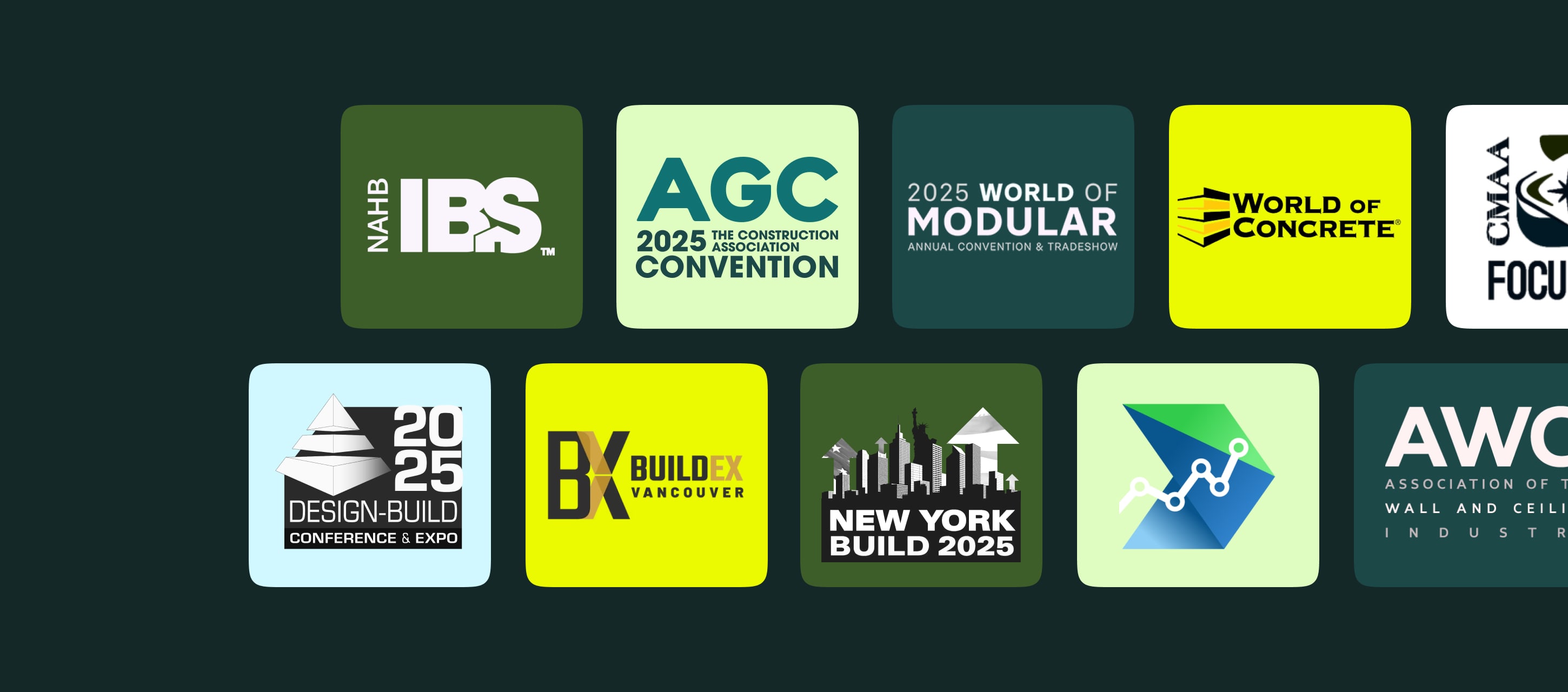The construction industry is set for big changes in 2025, with new tech, sustainability goals, and new workforce dynamics paving the way forward.
These opportunities are opening doors for building businesses of all sizes. Here’s what you need to know to make the most out of them.
Contents:
Workforce Dynamic
1. Persistent Labor Shortage
The construction industry is still facing a massive labor shortage, and it’s not going away anytime soon. A 2024 survey from the Associated General Contractors of America (AGC) highlights just how severe the issue has become.
Nearly every contractor surveyed reported open positions, with 94% struggling to fill roles for craft workers and 92% saying the same for salaried positions like project managers and superintendents.
Why are these positions so hard to fill? A big part of the problem comes down to preparation or lack of it. Many potential candidates simply don’t have the skills, certifications, or licenses required to succeed in these roles. In fact, 62% of firms say the candidates they’re seeing aren’t qualified for the job, while others struggle with issues like transportation and flexible work needs.
Despite these challenges, construction companies aren’t giving up. Many firms are stepping up their efforts to attract and retain talent. For example:
- Better pay: Over 60% of firms have increased wages for craft workers, and 45% have done the same for salaried employees.
- Training programs: Almost half of companies are investing in professional development, with many exploring online learning tools and virtual training to upskill their teams.
- Creative hiring strategies: Firms are using everything from social media to partnerships with schools to connect with potential employees.
Technology is also playing a bigger role in solving the labor crunch. Automation tools, VR training, and even robotics are helping firms do more with fewer workers.
While opinions are mixed on how these technologies will impact jobs in the long run, many agree they can make roles safer, more productive, and appealing to younger workers.
2. Collaboration Technology
In 2025, the construction industry is still struggling to improve communication between field teams and office staff. The Infrastructure & Projects Authority (IPA) has flagged this disconnect as a major reason for project delays and higher costs.
A lot of this trouble comes from outdated collaboration processes. Teams are still relying on paper checklists, scattered emails, and tools that just don’t talk to each other. Field crews often don’t have the latest updates, and office teams can’t see what’s happening on-site in real time.
But companies aren’t all standing still. More and more are turning to workflow automation platforms to bridge the gap. These tools make it easy to share information instantly, control field documentation, and manage daily reports.
Aside from streamlined document sharing, workflow automation provides real-time updates, and all team members can access the most up-to-date versions of documents and tasks. This eliminates the confusion when multiple people are working from different versions of a file. And improves the quality of your construction site data.
Imagine as a project manager you assign specific electrical tasks to team members using the workflow. These assignments are instantly visible to your team through the mobile app.
As the electrical work progresses – say a circuit is installed and tested – people update their task status in real time. If an unexpected issue happens, the person responsible documents it immediately using their mobile device. The issue is flagged for you to review and respond to this promptly.
And this is only one field task we talk about. Automation can help you improve collaboration with your partners and sub-contractors as well, synchronizing all the contracts and reports, and giving you one source of truth.
Read More Read More Dyna Crane is saving $300,000 and 3,000 hours a year with automated collaboration
3. Increased Safety Measures
The construction industry has the highest number of workplace fatalities in the U.S. and the second highest in the U.K. This harsh reality has fuelled a surge in safety innovations designed to protect workers.
Wearables and IoT devices are among the latest safety advancements. These tools monitor workers’ biometric data and environment, sending instant alerts to management in case of a fall or emergency
One example is Cat Detect for Personnel from Caterpillar; it incorporates RFID tags into wearers’ personal protective equipment, such as safety vests or hard hats.
Drones are another buzz word these days. Using them for aerial inspections helps identify potential safety hazards, assess site conditions, and monitor construction progress. Drones can reach difficult-to-access areas, reducing the need for workers to be exposed to risks in construction.
The data collected with drones can be used in BIM (building information modeling) to create 3-D models of the construction project. BIM allows for clash detection, helping identify potential conflicts in design that could lead to safety issues during construction.
Mobile apps will keep their importance for safety-critical industries as well. Equipping workers and supervisors with apps designed for safety management facilitates incident reporting, safety checklists filling, and provides easy access to safety manuals and procedures.
4. Design-Build
Design-build – where a single firm takes on the responsibilities of architects, contractors, and construction workers – is seeing a dramatic increase in popularity.
The single point of responsibility allows for smoother communication, more organized feedback, more organic teamwork, and faster product delivery. Industry buy-in has been unequivocal with 47 out of the 50 states now using design-build for their public construction projects.
Sustainability
5. Net Zero
The construction industry is already feeling the weight of net zero commitments, and these expectations are only growing. Governments, major investors, and influential organizations like the UK Green Building Council (UKGBC), Royal Institute of British Architects (RIBA), and American Institute of Architects (AIA) are backing initiatives to make net zero a reality.
The World Green Building Council’s Advancing Net Zero Commitment has laid out a clear roadmap for construction firms around the globe.
By 2030, all new buildings, renovations, and infrastructure are expected to cut embodied carbon by 40% and achieve net zero operational carbon. By 2050, the requirements expand to every building – new or old – reaching net zero in both embodied and operational carbon.
These aren’t easy goals to hit. They require rethinking everything, from the materials you choose to how your buildings run once they’re in use.
Naturally, challenges like construction cost control and the lack of standardized practices make the path forward even more difficult. But the benefits of getting it right are undeniable: staying ahead of regulations, meeting investor demands, and contributing to a greener future.
For companies that embrace net zero practices now, the rewards include stronger market positioning and the chance to lead the industry in a meaningful way.
6. Retrofitting
Retrofitting is becoming one of the most practical ways to bring older buildings up to modern energy standards. Instead of simply fixing outdated systems, retrofitting transforms buildings into more sustainable and cost-efficient spaces. From better insulation to renewable energy upgrades, it’s changing how the construction industry approaches sustainability.
And the benefits of retrofitting are hard to ignore. For starters, it helps lower energy costs by improving how buildings retain heat and reduces reliance on fossil fuels. Plus, it creates healthier spaces by improving air quality and reducing emissions.
But retrofitting comes with a very specific set of challenges. Many older buildings weren’t designed with modern systems in mind, which makes upgrading them hard. But that’s where technologies like digital twins are proving invaluable. By creating a virtual model of a building, construction teams can test out retrofitting solutions and spot potential issues before any physical work begins.
Visual tools like AR are also making a difference. Imagine showing a building owner how a retrofit project will look and perform before the first hammer is lifted. It’s a simple but effective way to build confidence and secure buy-in.
Technology
7. Process Automation
Automation has been here for many years. It will remain a trend both in 2025, and in the years coming after. Self-driving vehicles, AI and machine learning, digital twins, robotics, IoT sensors, safety automation – the list goes on.
What is new, however, is the anxiety many people have started having, fearing that automation will displace jobs. While it obviously has the potential to change the nature of jobs and tasks performed, it’s unlikely to replace people due to its complementary role.
For example, workflow automation in the construction industry can assist in specific tasks like task assignments, document routing, notifications and alerts, reporting, etc.
But skilled human labor, creativity, adaptation to new environments and complex decision-making will often require a level of judgment and attention to detail that automation lacks.
Imagine this. You use software that automatically assigns engineering tasks after architectural plans are approved. But when unexpected soil conditions require a revised foundation plan, it’s the engineering team who use their expertise to design a safe, compliant solution. And this won’t change anytime soon.
Read More Read More Top Procore alternatives for construction managers in 2025
8. Drone Technology
In 2025, drone technology, one of the stable AEC industry trends, is meant to transform construction practices by providing invaluable aerial insights, keeping in mind AEC data security. Drones can be employed for various purposes, including:
- Site surveys: Drones conduct detailed site surveys, capturing high-resolution images and data that inform project planning.
- Progress monitoring: They enable real-time progress monitoring, allowing for timely adjustments and issue resolution.
- Safety on construction site: Drones are used for safety inspections, identifying potential hazards and ensuring compliance.
These capabilities enhance project planning, minimize risks, and ensure accurate documentation, ultimately leading to more successful construction projects.
9. Virtual Reality (VR) and Augmented Reality (AR)
VR and AR technologies are changing the way construction projects are visualized and executed in 2025. These technologies offer:
- Design reviews: Architects and clients can virtually “walk through” a building before construction begins, ensuring design alignment and addressing concerns proactively.
- Real-time visualization: Real-time project visualization aids in decision-making, allowing stakeholders to assess progress and make informed choices.
- On-site guidance: AR overlays provide on-site guidance, helping workers with complex tasks and reducing errors.
For example, engineers and contractors can wear AR glasses to review the 3-D BIM design of the HVAC system. Multiple team members can simultaneously view and discuss the design in real time, even if they are not physically present at the site.
And during the installation phase, technicians can use AR glasses equipped with spatial tracking and mapping capabilities to locate the precise positions for equipment installation, minimizing errors and rework.
10. Data Ownership and Management
The industry’s growing reliance on technology has put data security in the spotlight like never before. It’s not enough to focus on the outcomes, construction firms need site management software that safeguards sensitive information and complies with local standards. Otherwise, the risks can outweigh the rewards.
What makes this even trickier is that data management compliance isn’t one-size-fits-all. In some areas, data has to be stored locally. In others, privacy laws like GDPR must be implemented at all costs. If your work crosses borders, figuring out whether the digital tools you trust with your information can feel like a project of its own.
But it must be done. You need to know where your data is going, how it’s being stored, and who has access to it. Ignoring these details could leave your company vulnerable to compliance headaches- or worse. What you don’t know can in fact hurt you.
Read More Read More Fluix is ISO 27001 certified: What it means for your business
Construction Methods
11. Modular & Prefabricated Construction
One of the recent architecture, engineering and construction (AEC) industry trends, modular and prefabricated construction, where a structure is constructed off-site and then delivered to the intended site, is seeing an increase in popularity.
Conditions at the offsite space allow for better and more consistent quality, and the building hours are shorter, saving labor costs and decreasing construction time by as much as 50%
The benefits this method brings for construction are numerous but the main ones are:
- Enhanced quality control: Offsite conditions allow for rigorous quality control, resulting in consistently high-quality structures.
- Reduced construction time: Construction timelines can be shortened by up to 50% due to parallel on-site and off-site work, leading to cost savings.
- Minimized labor costs: The decreased need for on-site labor translates to reduced labor costs.
Additionally, modular construction significantly reduces waste by facilitating the recycling of leftover materials, contributing to sustainability and better construction budgeting.
Many businesses and even countries have been exploring the modular potential. For example, in 2023, Singapore unveiled a remarkable 50-story modular skyscraper, adopting this method in a combination with BIM and virtual design and construction.
12. 3-D Printing
3-D Printing is poised to disrupt traditional construction methods in 2025. This technology allows for the rapid production of building components on-site, reducing material waste and construction time.
The advantages are cost-effective construction due to reduced material waste, labor requirements and sustainability.
3-D printing supports green tech by minimizing waste and using eco-friendly materials, allowing at the same time for design flexibility (another feature 3-D printing is loved for).
And these are some illustrative usage examples.
In 2021, the Netherlands saw the completion of its first 3D-printed concrete house, part of the ‘Milestone Project,’ demonstrating the viability of 3D printing in construction.
The single-story house boasts 94 square meters of space and complies with strict construction regulations. It features a unique design inspired by a large rock and excels in energy efficiency. The Milestone Project aims to revolutionize construction by using 3D printing to create sustainable, customizable homes.
In Georgetown, Texas, ICON is completing the largest 3D-printed neighborhood in the world. Their robotic printers are constructing 100 homes in the Wolf Ranch community, located just outside Austin. The three- to four- bedroom homes take only three weeks to print, although the foundations and metal roofs are being installed using traditional construction methods.
Connor Jenkins, the ICON senior project manager, had high praise for 3-D printing: “It brings a lot of efficiency to the trade market…So, where there were maybe five different crews coming in to build a wall system, we now have one crew and one robot.”
Last Word
As you see, the future of construction is both exciting and transformative, and those who embrace new construction business trends will be well-positioned for growth and success.
Fluix can help you with this, providing the best solutions for workflow automation, site data collection, and reporting. We will help you get started with first workflows (if you’re new to them), onboard your teams properly, and start making a difference for your business.







